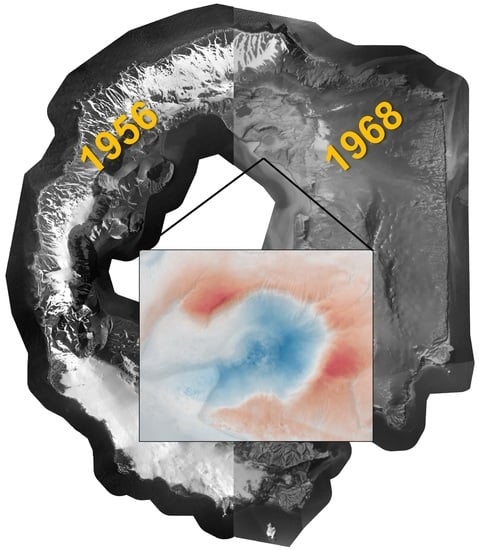Deception Island 1967–1970 Volcano Eruptions from Historical Aerial Frames and Satellite Imagery (Antarctic Peninsula)
Abstract
1. Introduction
1.1. Recent Volcanism and Tectonic Surrounding
1.2. Cartographic Products and Imagery of Deception Island
2. Methods and Materials
2.1. Structure from Motion and Rational Polynomial Processing
2.2. Historical Aerial Frames and Satellite Imagery
3. Results
3.1. Accuracy Assessment of New Digital Cartographic Products
3.2. New Digital Cartographic Products Historical Aerial Frames Based
4. Discussion
4.1. The 1967–1970 Eruptive Sequence: 1967 Phase
4.2. The 1967–1970 Eruptive Sequence: 1970 Phases
5. Conclusions
Author Contributions
Funding
Data Availability Statement
Acknowledgments
Conflicts of Interest
Appendix A


Appendix B
| GNSS | 1956 | 1968 | 2020 | ||||
|---|---|---|---|---|---|---|---|
| X (m) | Y (m) | X (m) | Y (m) | X (m) | Y (m) | X (m) | Y (m) |
| 616,400.428 | 3,014,773.067 | - | - | 616,399.353 | 3,014,773.858 | 616,401.355 | 3,014,774.258 |
| 616,398.094 | 3,014,772.781 | - | - | 616,396.950 | 3,014,773.698 | 616,398.312 | 3,014,774.418 |
| 616,397.882 | 3,014,775.195 | - | - | 616,396.790 | 3,014,776.261 | 616,398.152 | 3,014,777.462 |
| 616,548.713 | 3,014,881.153 | - | - | - | - | 616,548.803 | 3,014,881.260 |
| 616,571.922 | 3,014,909.085 | - | - | 616,571.709 | 3,014,909.452 | 616,571.709 | 3,014,908.331 |
| 616,573.190 | 3,014,912.727 | - | - | 616,572.991 | 3,014,912.816 | 616,572.671 | 3,014,912.015 |
| 616,570.457 | 3,014,913.903 | - | - | 616,570.268 | 3,014,913.457 | 616,569.947 | 3,014,912.976 |
| 616,569.054 | 3,014,909.696 | - | - | 616,568.986 | 3,014,910.093 | 616,568.506 | 3,014,908.812 |
| 616,551.933 | 3,014,909.751 | - | - | 616,552.167 | 3,014,909.212 | 616,551.046 | 3,014,908.411 |
| 616,547.347 | 3,014,906.706 | - | - | 616,548.002 | 3,014,906.970 | 616,547.041 | 3,014,907.290 |
| 616,541.279 | 3,014,916.869 | 616,539.032 | 3,014,904.407 | 616,539.032 | 3,014,904.567 | 616,538.231 | 3,014,904.887 |
| 616,539.739 | 3,014,909.211 | 616,531.504 | 3,014,906.489 | 616,531.824 | 3,014,906.809 | 616,540.153 | 3,014,908.732 |
| 616,538.606 | 3,014,904.795 | 616,539.833 | 3,014,909.372 | 616,539.833 | 3,014,909.372 | 616,531.664 | 3,014,906.809 |
| 616,531.758 | 3,014,906.453 | 616,541.435 | 3,014,917.061 | 616,541.755 | 3,014,917.381 | 616,541.915 | 3,014,917.061 |
| 616,533.926 | 3,014,915.593 | 616,534.521 | 3,014,915.284 | 616,534.256 | 3,014,915.813 | 616,533.992 | 3,014,915.416 |
| 616,529.113 | 3,014,912.659 | 616,530.023 | 3,014,912.109 | 616,529.626 | 3,014,913.035 | 616,529.097 | 3,014,912.770 |
| 616,526.710 | 3,014,918.052 | 616,527.245 | 3,014,917.665 | 616,529.097 | 3,014,911.976 | 616,526.186 | 3,014,918.062 |
| 616,537.317 | 3,014,924.062 | 616,537.431 | 3,014,923.486 | 616,534.653 | 3,014,916.077 | 616,537.299 | 3,014,923.883 |
| 616,526.149 | 3,014,928.643 | 616,525.922 | 3,014,928.248 | 616,526.848 | 3,014,918.459 | 616,526.054 | 3,014,928.645 |
| 616,545.441 | 3,014,921.745 | 616,545.633 | 3,014,921.369 | 616,545.369 | 3,014,922.031 | 616,544.972 | 3,014,921.898 |
| 616,550.641 | 3,014,924.271 | 616,550.793 | 3,014,924.015 | 616,550.396 | 3,014,924.147 | 616,550.528 | 3,014,924.809 |
| 616,551.420 | 3,014,929.410 | 616,551.057 | 3,014,929.571 | 616,552.248 | 3,014,932.878 | 616,551.057 | 3,014,929.703 |
| 616,552.423 | 3,014,932.971 | 616,552.248 | 3,014,933.275 | 616,552.248 | 3,014,932.878 | 616,552.248 | 3,014,932.878 |
| 616,549.195 | 3,014,934.023 | 616,548.676 | 3,014,933.540 | 616,548.941 | 3,014,934.201 | 616,548.941 | 3,014,933.672 |
| 616,538.748 | 3,014,935.236 | 616,539.151 | 3,014,934.863 | 616,539.151 | 3,014,934.995 | 616,538.622 | 3,014,935.127 |
| 616,538.957 | 3,014,930.255 | 616,538.886 | 3,014,929.703 | 616,539.019 | 3,014,930.100 | 616,538.754 | 3,014,929.968 |
| 616,555.562 | 3,014,941.081 | 616,555.291 | 3,014,940.816 | 616,555.555 | 3,014,940.684 | 616,555.687 | 3,014,941.345 |
| 616,557.280 | 3,014,946.949 | 616,557.143 | 3,014,946.372 | 616,556.878 | 3,014,946.108 | 616,557.143 | 3,014,946.108 |
| 616,551.016 | 3,014,942.213 | 616,550.660 | 3,014,942.271 | 616,550.396 | 3,014,941.874 | 616,550.925 | 3,014,942.139 |
| 616,552.956 | 3,014,949.106 | 616,552.248 | 3,014,948.489 | 616,552.248 | 3,014,948.357 | 616,552.645 | 3,014,948.753 |
| 616,541.318 | 3,014,945.563 | 616,541.665 | 3,014,945.182 | 616,541.268 | 3,014,945.049 | 616,541.797 | 3,014,945.314 |
| 616,543.624 | 3,014,951.815 | 616,543.252 | 3,014,951.002 | 616,543.517 | 3,014,951.002 | 616,543.649 | 3,014,951.532 |
| 616,548.336 | 3,014,992.703 | 616,548.544 | 3,014,991.881 | 616,547.485 | 3,014,992.277 | 616,548.147 | 3,014,992.145 |
| 616,721.362 | 3,015,040.519 | - | - | 616,721.052 | 3,015,040.961 | 616,720.787 | 3,015,041.490 |
| 616,700.576 | 3,015,041.205 | 616,701.208 | 3,015,040.035 | 616,700.811 | 3,015,040.299 | 616,699.224 | 3,015,040.696 |
| 616,666.176 | 3,015,041.956 | 616,667.077 | 3,015,041.225 | 616,667.342 | 3,015,041.754 | 616,666.548 | 3,015,041.622 |
| 616,654.683 | 3,015,047.262 | 616,655.303 | 3,015,046.914 | 616,654.774 | 3,015,046.517 | 616,654.642 | 3,015,047.178 |
| 616,668.352 | 3,015,075.181 | 616,669.326 | 3,015,073.901 | 616,669.061 | 3,015,074.960 | 616,668.665 | 3,015,075.489 |
| 622,202.551 | 3,019,264.360 | 622,201.896 | 3,019,263.711 | 622,201.234 | 3,019,263.314 | 622,201.499 | 3,019,263.578 |
| 622,196.579 | 3,019,264.044 | 622,194.487 | 3,019,263.843 | 622,195.546 | 3,019,263.049 | 622,195.017 | 3,019,263.446 |
| 622,195.831 | 3,019,281.200 | 622,194.223 | 3,019,281.173 | 622,194.752 | 3,019,280.776 | 622,195.149 | 3,019,280.512 |
| 622,194.891 | 3,019,289.453 | 622,194.091 | 3,019,289.111 | 622,194.487 | 3,019,288.449 | 622,194.620 | 3,019,289.243 |
| 622,194.726 | 3,019,291.951 | 622,194.091 | 3,019,292.550 | 622,194.620 | 3,019,291.624 | 622,194.620 | 3,019,291.492 |
| 622,197.156 | 3,019,291.930 | 622,197.266 | 3,019,292.418 | 622,197.001 | 3,019,291.624 | 622,197.001 | 3,019,291.624 |
| 622,197.093 | 3,019,289.361 | 622,197.398 | 3,019,289.508 | 622,197.133 | 3,019,289.375 | 622,197.001 | 3,019,289.375 |
| 623,371.825 | 3,014,483.666 | 623,371.784 | 3,014,484.410 | 623,372.677 | 3,014,482.822 | 623,371.288 | 3,014,484.013 |
| 623,380.936 | 3,014,487.817 | 623,381.706 | 3,014,487.188 | 623,383.591 | 3,014,487.386 | 623,380.813 | 3,014,488.577 |
| 623,428.358 | 3,014,507.872 | 623,428.537 | 3,014,507.428 | 623,429.232 | 3,014,507.627 | 623,429.232 | 3,014,507.825 |
| 623,440.511 | 3,014,513.288 | 623,440.642 | 3,014,512.786 | 623,441.336 | 3,014,513.382 | 623,440.543 | 3,014,513.580 |
| 623,438.680 | 3,014,515.133 | 623,438.658 | 3,014,514.771 | 623,438.558 | 3,014,515.366 | 623,438.757 | 3,014,514.969 |
| 623,437.702 | 3,014,517.809 | 623,437.665 | 3,014,517.549 | 623,437.765 | 3,014,518.541 | 623,437.765 | 3,014,517.747 |
| 623,429.404 | 3,014,514.572 | 623,428.140 | 3,014,514.175 | 623,429.033 | 3,014,514.969 | 623,429.827 | 3,014,514.771 |
| 623,430.354 | 3,014,511.936 | 623,428.934 | 3,014,511.596 | 623,430.621 | 3,014,511.794 | 623,430.422 | 3,014,511.794 |
| 623,394.171 | 3,014,576.698 | 623,394.307 | 3,014,576.981 | 623,394.604 | 3,014,576.882 | 623,394.704 | 3,014,577.080 |
| 623,393.688 | 3,014,582.304 | 623,393.711 | 3,014,581.148 | 623,393.612 | 3,014,581.842 | 623,394.108 | 3,014,583.430 |
| 623,402.655 | 3,014,583.675 | 623,403.236 | 3,014,583.728 | 623,403.733 | 3,014,583.628 | 623,404.427 | 3,014,584.819 |
| 623,403.574 | 3,014,578.981 | 623,404.030 | 3,014,578.370 | 623,404.526 | 3,014,578.469 | 623,405.022 | 3,014,580.652 |
References
- Robertson Maurice, S.D.; Wiens, D.A.; Shore, P.J.; Vera, E.; Dorman, L.M. Seismicity and Tectonics of the South Shetland Islands and Bransfield Strait from a Regional Broadband Seismograph Deployment. J. Geophys. Res. Solid Earth 2003, 108. [Google Scholar] [CrossRef]
- Taylor, F.W.; Bevis, M.G.; Dalziel, I.W.D.; Smalley, R.; Frohlich, C.; Kendrick, E.; Foster, J.; Phillips, D.; Gudipati, K. Kinematics and Segmentation of the South Shetland Islands- Bransfield Basin System, Northern Antarctic Peninsula. Geochem. Geophys. Geosyst. 2008, 9. [Google Scholar] [CrossRef]
- Jin, Y.K.; Lee, J.; Hong, J.K.; Nam, S.H. Is Subduction Ongoing in the South Shetland Trench, Antarctic Peninsula?: New Constraints from Crustal Structures of Outer Trench Wall. Geosci. J. 2009, 13, 59–67. [Google Scholar] [CrossRef]
- Maestro, A.; Somoza, L.; Rey, J.; Martínez-Frías, J.; López-Martínez, J. Active Tectonics, Fault Patterns, and Stress Field of Deception Island: A Response to Oblique Convergence between the Pacific and Antarctic Plates. J. S. Am. Earth Sci. 2007, 23, 256–268. [Google Scholar] [CrossRef]
- Solari, M.A.; Hervé, F.; Martinod, J.; Le Roux, J.P.; Ramírez, L.E.; Palacios, C. Geotectonic Evolution of the Bransfield Basin, Antarctic Peninsula: Insights from Analogue Models. Antarct. Sci. 2008, 20, 185–196. [Google Scholar] [CrossRef]
- Berrocoso, M.; Fernández-Ros, A.; Prates, G.; García, A.; Kraus, S. Geodetic Implications on Block Formation and Geodynamic Domains in the South Shetland Islands, Antarctic Peninsula. Tectonophysics 2016, 666, 211–219. [Google Scholar] [CrossRef]
- González-Casado, J.M.; Giner-Roles, J.L.; López-Martinez, J. Bransfield Basin, Antarctic Peninsula: Not a normal backarc basin. Geology 2000, 28, 1043–1046. [Google Scholar] [CrossRef]
- Fretzdorff, S.; Worthington, T.J.; Haase, K.M.; Hékinian, R.; Franz, L.; Keller, R.A.; Stoffers, P. Magmatism in the Bransfield Basin: Rifting of the South Shetland Arc? J. Geophys. Res. Solid Earth 2004, 109. [Google Scholar] [CrossRef]
- Smellie, J.L. Lithostratigraphy and volcanic evolution of Deception Island, South Shetland Islands. Antarct. Sci. 2001, 13, 188–209. [Google Scholar] [CrossRef]
- Torrecillas, C.; Berrocoso, M.; Felpeto, A.; Torrecillas, M.D.; Garcia, A. Reconstructing Palaeo-Volcanic Geometries Using a Geodynamic Regression Model (GRM): Application to Deception Island Volcano (South Shetland Islands, Antarctica). Geomorphology 2013, 182, 79–88. [Google Scholar] [CrossRef]
- Smellie, J.L.; López-Martinez, J.; Headland, R.K.; Hernandéz-Cifuentes, F.; Maestro, A.; Miller, I.L.; Rey, J.; Serrano, E.; Somoza, L.; Thomson, M.R.A. Geology and geomorphology of Deception Island. In BAS GEOMAP Series; British Antarctic Survey: Cambridge, UK, 2002; Sheet 6A and 6B, 1:25 000, with supplementary text, 3 pp. [Google Scholar]
- Torrecillas, C.; Berrocoso, M.; Pérez-López, R.; Torrecillas, M.D. Determination of Volumetric Variations and Coastal Changes Due to Historical Volcanic Eruptions Using Historical Maps and Remote-Sensing at Deception Island (West-Antarctica). Geomorphology 2012, 136, 6–14. [Google Scholar] [CrossRef]
- Pedrazzi, D.; Németh, K.; Geyer, A.; Álvarez-Valero, A.M.; Aguirre-Díaz, G.; Bartolini, S. Historic Hydrovolcanism at Deception Island (Antarctica): Implications for Eruption Hazards. Bull. Volcanol. 2018, 80, 11. [Google Scholar] [CrossRef]
- Carmona, E.; Almendros, J.; Serrano, I.; Stich, D.; Ibáñez, J.M. Results of Seismic Monitoring Surveys of Deception Island Volcano, Antarctica, from 1999-2011. Antarct. Sci. 2012, 24, 485–499. [Google Scholar] [CrossRef]
- Ortiz, R.; García, A.; Aparicio, A.; Blanco, I.; Felpeto, A.; Del Rey, R.; Villegas, M.; Ibáñez, J.M.; Morales, J.; Del Pezzo, E.; et al. Monitoring of the volcanic activity of Deception Island, South Shetland Islands, Antarctica (1986–1995). In The Antarctic Region: Geological Evolution and Processes; Ricci, C.A., Ed.; Terra Antarctica PublicationL: Siena, Italy, 1997; pp. 1071–1076. [Google Scholar]
- Ibáñez, J.M.; Del Pezzo, E.; Almendros, J.; La Rocca, M.; Alguacil, G.; Ortiz, R.; García, A. Seismovolcanic Signals at Deception Island Volcano, Antarctica: Wave Field Analysis and Source Modeling. J. Geophys. Res. Solid Earth 2000, 105, 13905–13931. [Google Scholar] [CrossRef]
- Ibánez, J.M.; Carmona, E.; Almendros, J.; Saccorotti, G.; Del Pezzo, E.; Abril, M.; Ortiz, R. The 1998-1999 Seismic Series at Deception Island Volcano, Antarctica. J. Volcanol. Geotherm. Res. 2003, 128, 65–88. [Google Scholar] [CrossRef]
- Berrocoso, M.; Prates, G.; Fernández-Ros, A.; Peci, L.M.; de Gil, A.; Rosado, B.; Páez, R.; Jigena, B. Caldera Unrest Detected with Seawater Temperature Anomalies at Deception Island, Antarctic Peninsula. Bull. Volcanol. 2018, 80, 41. [Google Scholar] [CrossRef]
- Moreno-Vacas, A.; Almendros, J. On the Origin of Recent Seismic Unrest Episodes at Deception Island Volcano, Antarctica. J. Volcanol. Geotherm. Res. 2021, 419, 107376. [Google Scholar] [CrossRef]
- Núñez-Regodón, J. Diario de Operaciones 2019/2020 del Ejército de Tierra de España. 2020. Available online: https://ejercito.defensa.gob.es/unidades/Antartica/antartica/index.html (accessed on 24 February 2023).
- García, A.; Blanco, I.; Torta, J.M.; Astiz, M.M.; Ibáñez, J.M.; Ortiz, R. A Search for the Volcanomagnetic Signal at Deception Volcano (South Shetland I., Antarctica). Ann. Geophys. 1997, 40. [Google Scholar] [CrossRef]
- Zandomeneghi, D.; Barclay, A.; Almendros, J.; Godoy, J.M.I.; Wilcock, W.S.D.; Ben-Zvi, T. Crustal Structure of Deception Island Volcano from P Wave Seismic Tomography: Tectonic and Volcanic Implications. J. Geophys. Res. Solid Earth 2009, 114. [Google Scholar] [CrossRef]
- Prudencio, J.; De Siena, L.; Ibáñez, J.M.; Del Pezzo, E.; García-Yeguas, A.; Díaz-Moreno, A. The 3D Attenuation Structure of Deception Island (Antarctica). Surv. Geophys. 2015, 36, 371–390. [Google Scholar] [CrossRef]
- Padrón, E.; Hernández, P.A.; Carmona, E.; Pérez, N.M.; Melián, G.; Sumino, H.; Almendros, J.; Kusakabe, M.; Wakita, H.; Padilla, G.D. Geochemical Evidence of Different Sources of Long-Period Seismic Events at Deception Volcano, South Shetland Islands, Antarctica. Antarct. Sci. 2015, 27, 557–565. [Google Scholar] [CrossRef]
- Bartolini, S.; Geyer, A.; Martí, J.; Pedrazzi, D.; Aguirre-Díaz, G. Volcanic Hazard on Deception Island (South Shetland Islands, Antarctica). J. Volcanol. Geotherm. Res. 2014, 285, 150–168. [Google Scholar] [CrossRef]
- Pedrazzi, D.; Aguirre-Díaz, G.; Bartolini, S.; Martí, J.; Geyer, A. The 1970 Eruption on Deception Island (Antarctica): Eruptive Dynamics and Implications for Volcanic Hazards. J. Geol. Soc. Lond. 2014, 171, 765–778. [Google Scholar] [CrossRef]
- Aristarain, A.J.; Delmas, R. First Glaciological Studies on the James Ross Island Ice Cap, Antarctic Peninsula. J. Glaciol. 1981, 27, 371–379. [Google Scholar] [CrossRef]
- Pallàs, R.; Smellie, J.L.; Casas, J.M.; Calvet, J. Using Tephrochronology to Date Temperate Ice: Correlation between Ice Tephras on Livingston Island and Eruptive Units on Deception Island Volcano (South Shetland Islands, Antarctica). Holocene 2001, 11, 149–160. [Google Scholar] [CrossRef]
- Roobol, M.J. The Volcanic Hazard at Deception Island, South Shetland Islands. Br. Antarct. Surv. Bull. 1982, 51, 237–245. [Google Scholar]
- Baker, P.; Roobol, M.; McReath, M.; Harvey, M.; Davies, T. The geology of the South Shetland Islands. Volcanic evolution of Deception Island: Introduction. In British Antarctic Survey Scientific Reports; British Antarctic Survey: Cambridge, UK, 1975; Volume 78. [Google Scholar]
- Brecher, H.H. Photogrammetric Maps of a Volcanic Eruption Area, Deception Island, Antarctica. In Institute of Polar Studies Report No. 52; Research Foundation and the Institute of Polar Studies, The Ohio State University: Columbus, OH, USA, 1975; Volume 52, 10p. [Google Scholar]
- Smellie, J.L. The 1969 Subglacial Eruption on Deception Island (Antarctica): Events and Processes during an Eruption beneath a Thin Glacier and Implications for Volcanic Hazards. Geol. Soc. London, Spec. Publ. 2002, 202, 59–79. [Google Scholar] [CrossRef]
- Berrocoso, M.; Torrecillas, C.; Jigena, B.; Fernández-Ros, A. Determination of Geomorphological and Volumetric Variations in the 1970 Land Volcanic Craters Area (Deception Island, Antarctica) from 1968 Using Historical and Current Maps, Remote Sensing and GNSS. Antarct. Sci. 2012, 24, 367–376. [Google Scholar] [CrossRef]
- Diefenbach, A.K.; Crider, J.G.; Schilling, S.P.; Dzurisin, D. Rapid, Low-Cost Photogrammetry to Monitor Volcanic Eruptions: An Example from Mount St. Helens, Washington, USA. Bull. Volcanol. 2012, 74, 579–587. [Google Scholar] [CrossRef]
- Gomez, C. Digital Photogrammetry and GIS-Based Analysis of the Bio-Geomorphological Evolution of Sakurajima Volcano, Diachronic Analysis from 1947 to 2006. J. Volcanol. Geotherm. Res. 2014, 280, 1–13. [Google Scholar] [CrossRef]
- Dvigalo, V.; Shevchenko, A.; Svirid, I. Photogrammetric Survey in Volcanology: A Case Study for Kamchatka Active Volcanoes. In Updates in Volcanology—From Volcano Modelling to Volcano Geology; InTechOpen: London, UK, 2016. [Google Scholar]
- Gomez, C.; Setiawan, M.A.; Listyaningrum, N.; Wibowo, S.B.; Hadmoko, D.S.; Suryanto, W.; Darmawan, H.; Bradak, B.; Daikai, R.; Sunardi, S.; et al. LiDAR and UAV SfM-MVS of Merapi Volcanic Dome and Crater Rim Change from 2012 to 2014. Remote Sens. 2022, 14, 5193. [Google Scholar] [CrossRef]
- Román, A.; Tovar-Sánchez, A.; Roque-Atienza, D.; Huertas, I.E.; Caballero, I.; Fraile-Nuez, E.; Navarro, G. Unmanned Aerial Vehicles (UAVs) as a Tool for Hazard Assessment: The 2021 Eruption of Cumbre Vieja Volcano, La Palma Island (Spain). Sci. Total Environ. 2022, 843, 157092. [Google Scholar] [CrossRef]
- Knuth, F.; Shean, D.; Bhushan, S.; Schwat, E.; Alexandrov, O.; McNeil, C.; Dehecq, A.; Florentine, C.; O’Neel, S. Historical Structure from Motion (HSfM): Automated processing of historical aerial photographs for long-term topographic change analysis. Remote Sens. Environ 2023, 285, 113379. [Google Scholar] [CrossRef]
- Howat, I.M.; Porter, C.; Smith, B.E.; Noh, M.J.; Morin, P. The Reference Elevation Model of Antarctica. Cryosphere 2019, 13, 665–674. [Google Scholar] [CrossRef]
- Kääb, A.; Vollmer, M. Surface Geometry, Thickness Changes and Flow Fields on Creeping Mountain Permafrost: Automatic Extraction by Digital Image Analysis. Permafr. Periglac. Process. 2000, 11, 315–326. [Google Scholar] [CrossRef]
- Westoby, M.J.; Brasington, J.; Glasser, N.F.; Hambrey, M.J.; Reynolds, J.M. “Structure-from-Motion” Photogrammetry: A Low-Cost, Effective Tool for Geoscience Applications. Geomorphology 2012, 179, 300–314. [Google Scholar] [CrossRef]
- Snavely, N.; Seitz, S.M.; Szeliski, R. Modeling the World from Internet Photo Collections. Int. J. Comput. Vis. 2008, 80, 189–210. [Google Scholar] [CrossRef]
- Furukawa, Y.; Ponce, J. Accurate, Dense, and Robust Multi-View Stereopsis. In Proceedings of the IEEE Computer Society Conference on Computer Vision and Pattern Recognition, Minneapolis, MN, USA, 17–22 June 2007. [Google Scholar] [CrossRef]
- Tao, C.V.; Hu, Y. A Comprehensive Study of the Rational Function Model for Photogrammetric Processing. Photogramm. Eng. Remote Sens. 2001, 67, 1347–1358. [Google Scholar]
- Marí, R.; de Franchis, C.; Meinhardt-Llopis, E.; Anger, J.; Facciolo, G. A Generic Bundle Adjustment Methodology for Indirect RPC Model Refinement of Satellite Imagery. Image Process. Line 2021, 11, 344–373. [Google Scholar] [CrossRef]
- Lillesand, T.; Kiefer, R.W.; Chipman, J. Remote Sensing and Image Interpretation, 7th ed.; Wiley: Hoboken, NJ, USA, 2015; ISBN 9781118919453. [Google Scholar]
- Jigena, B.; Berrocoso, M.; Torrecillas, C.; Vidal, J.; Barbero, I.; Fernandez-Ros, A. Determination of an Experimental Geoid at Deception Island, South Shetland Islands, Antarctica. Antarct. Sci. 2016, 28, 277–292. [Google Scholar] [CrossRef]
- Torrecillas, C.; Berrocoso, M.; García-García, A. The Multidisciplinary Scientific Information Support System (SIMAC) for Deception Island. In Antarctica: Contributions to Global Earth Sciences; Springer: Berlin/Heidelberg, Germany, 2006. [Google Scholar]
- Roobol, M.J. A model for the eruptive mechanism of Deception Island from 1820 to 1970. Br. Antarct. Surv. Bull. 1979, 49, 137–156. [Google Scholar]
- Flexas, M.M.; Arias, M.R.; Ojeda, M.A. Hydrography and Dynamics of Port Foster, Deception Island, Antarctica. Antarct. Sci. 2017, 29, 83–93. [Google Scholar] [CrossRef]
- Hopfenblatt, J.; Geyer, A.; Aulinas, M.; Álvarez-Valero, A.M.; Sánchez, A.P.; Giralt, S.; Smellie, J.L. DecTephra: A New Database of Deception Island’s Tephra Record (Antarctica). J. Volcanol. Geotherm. Res. 2022, 425, 107516. [Google Scholar] [CrossRef]
- Oliva, M.; Navarro, F.; Hrbáček, F.; Hernández, A.; Nývlt, D.; Pereira, P.; Ruiz-Fernández, J.; Trigo, R. Recent Regional Climate Cooling on the Antarctic Peninsula and Associated Impacts on the Cryosphere. Sci. Total Environ. 2017, 580, 210–223. [Google Scholar] [CrossRef] [PubMed]

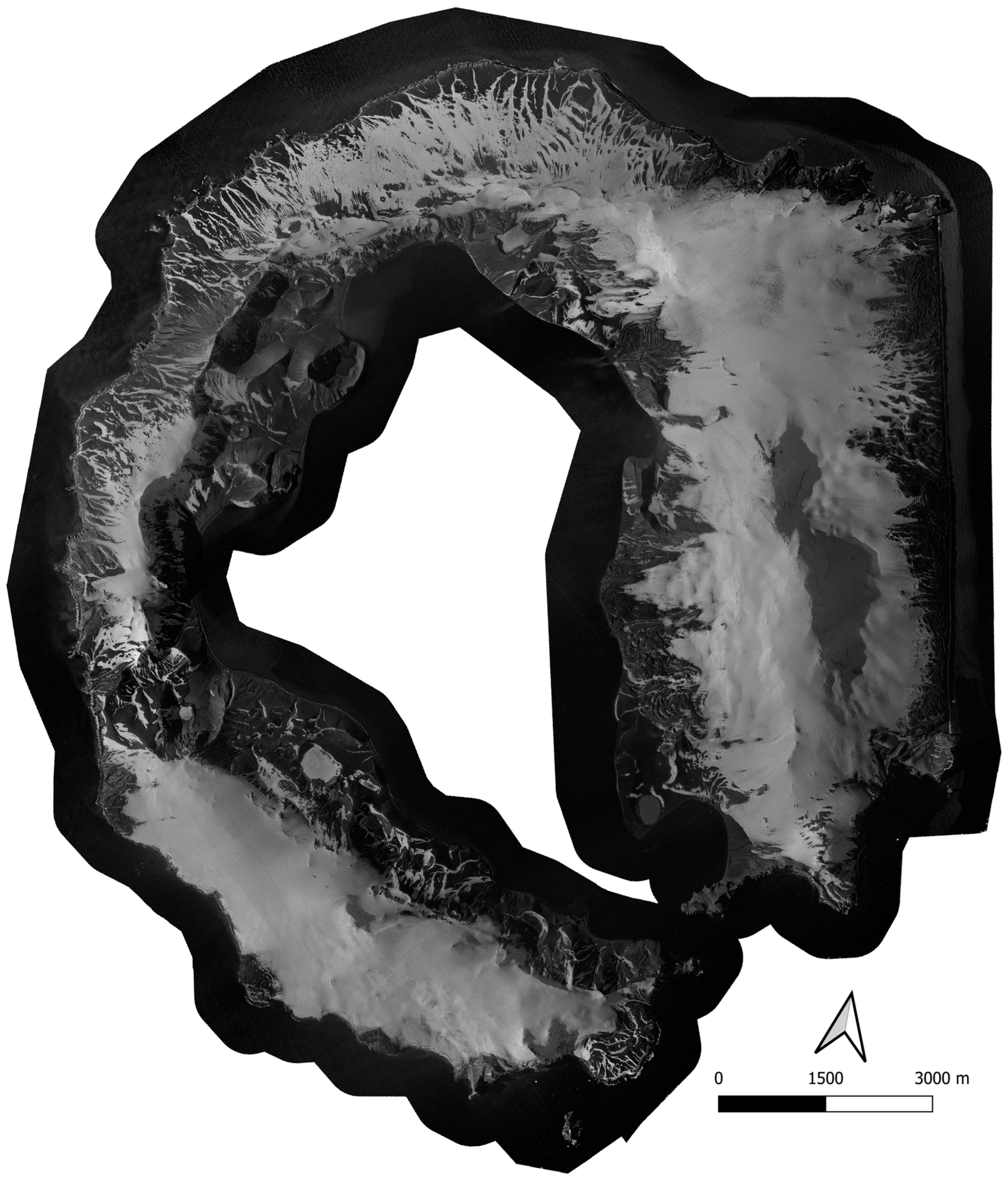
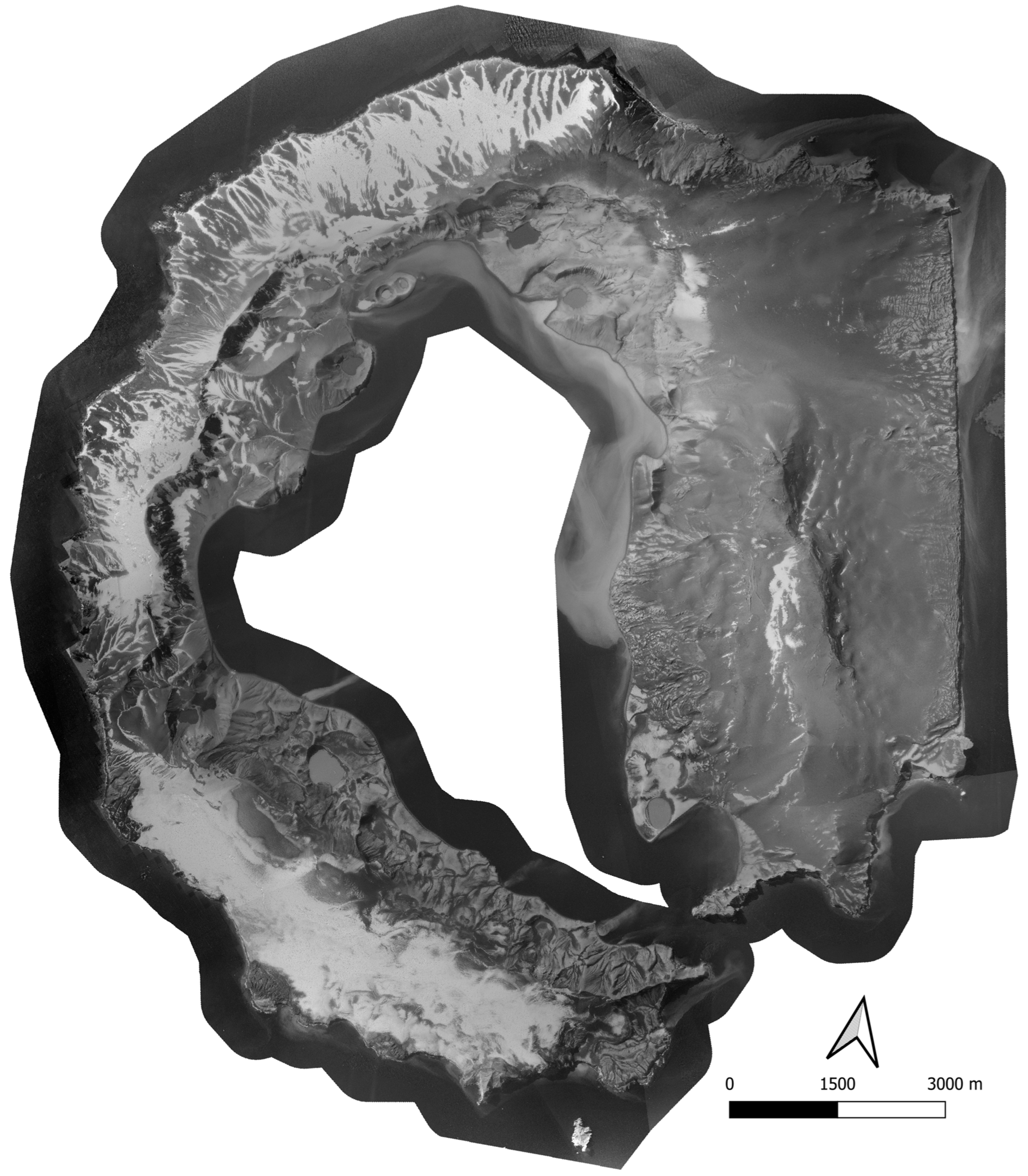
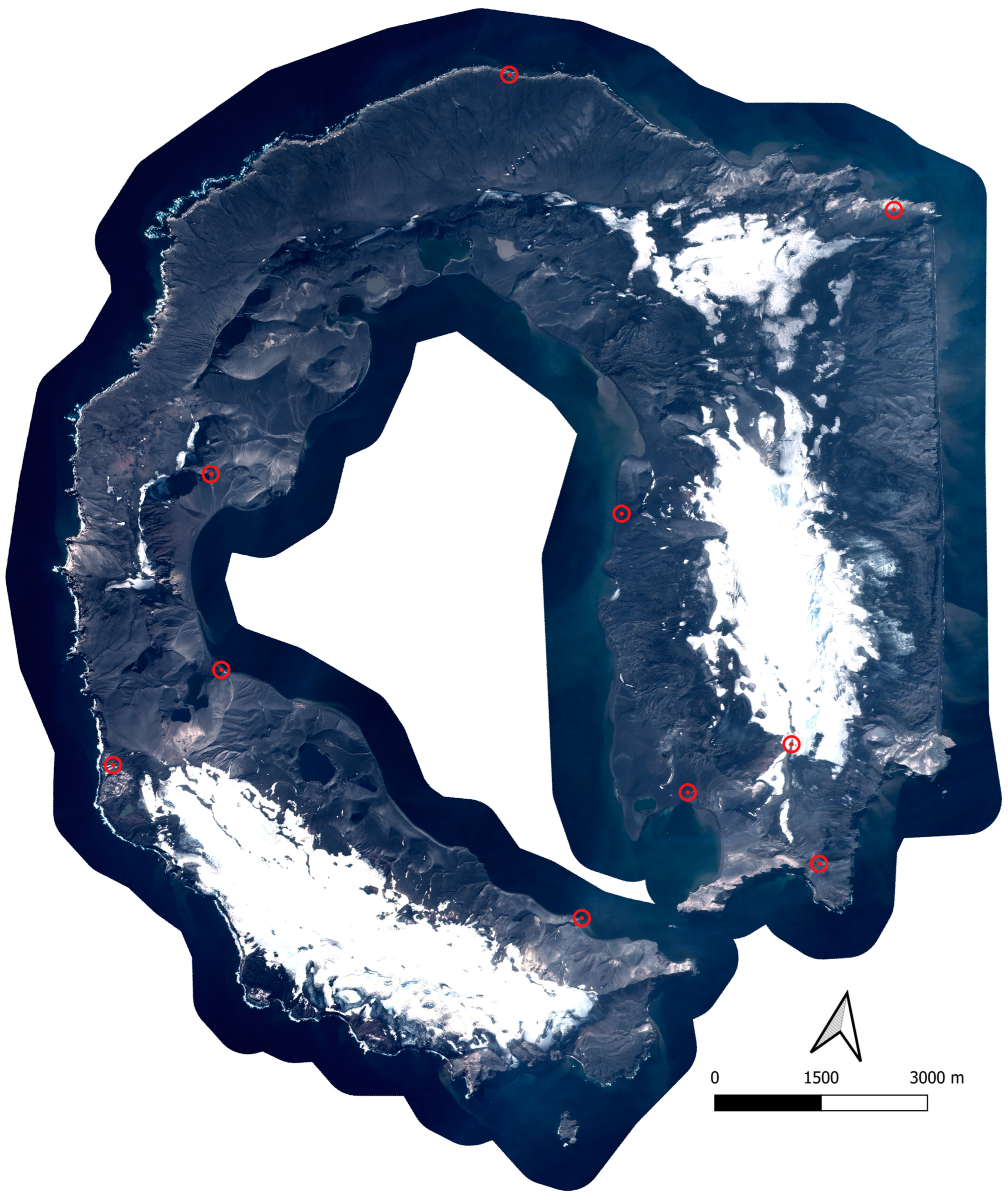

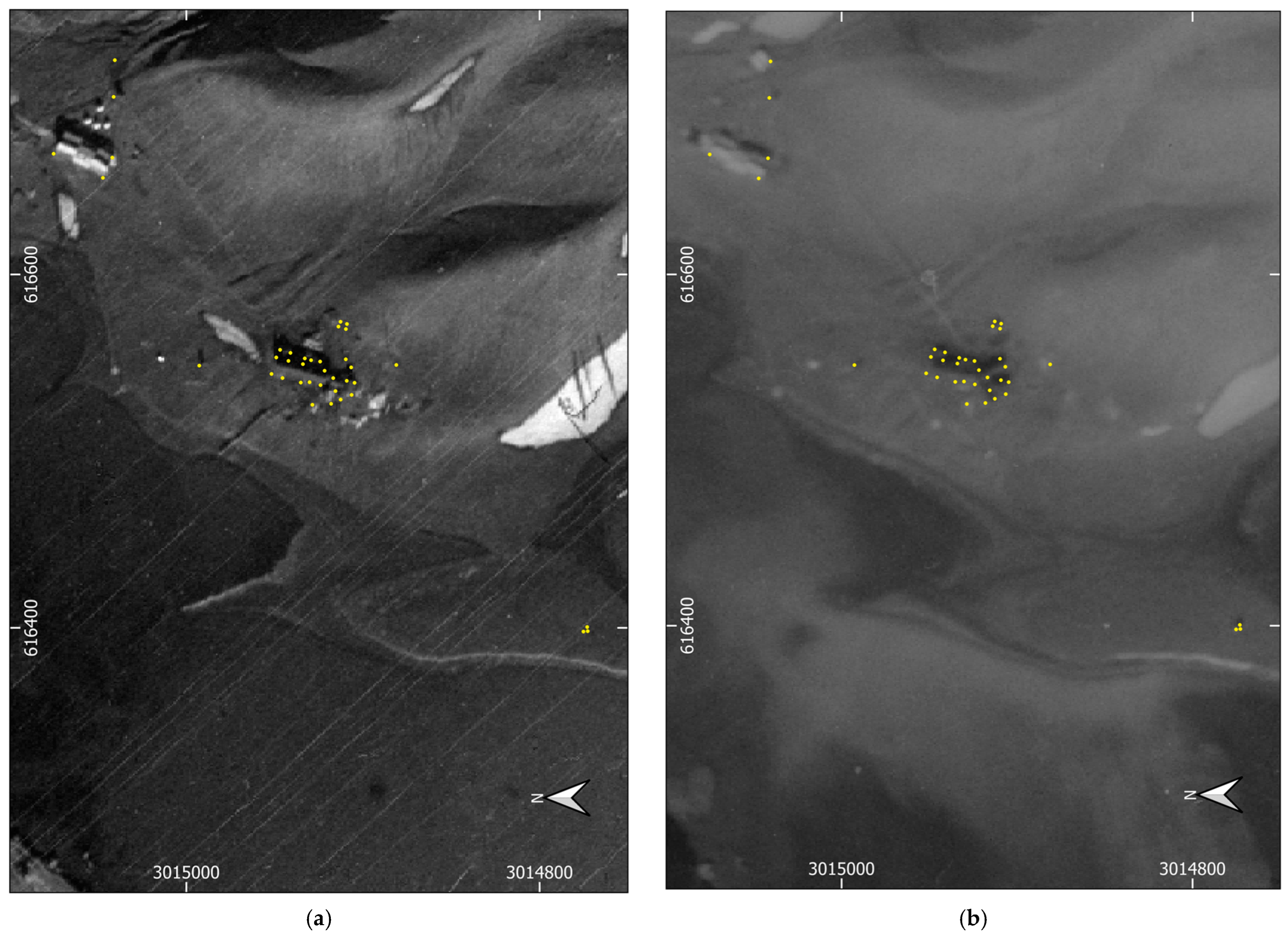
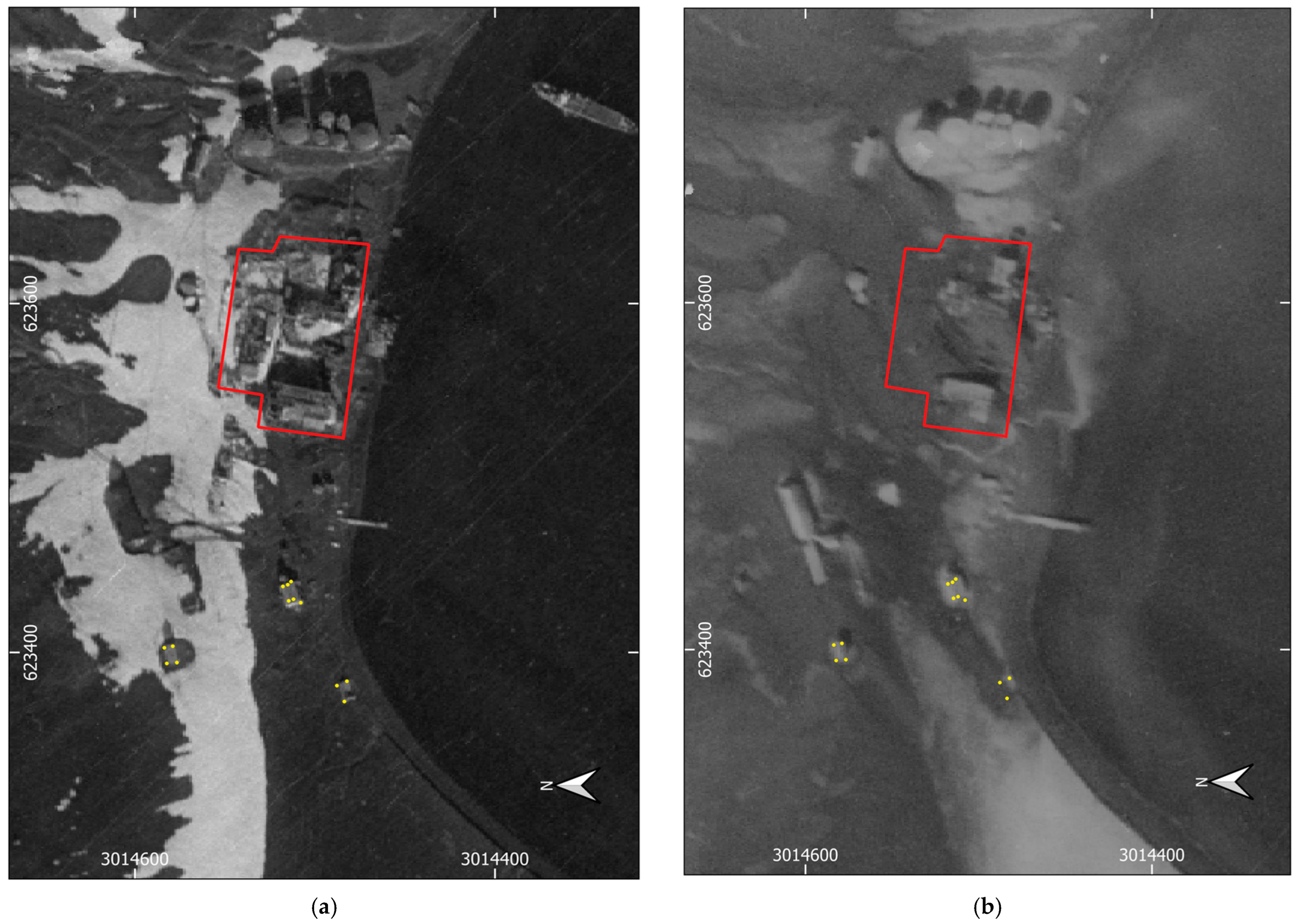
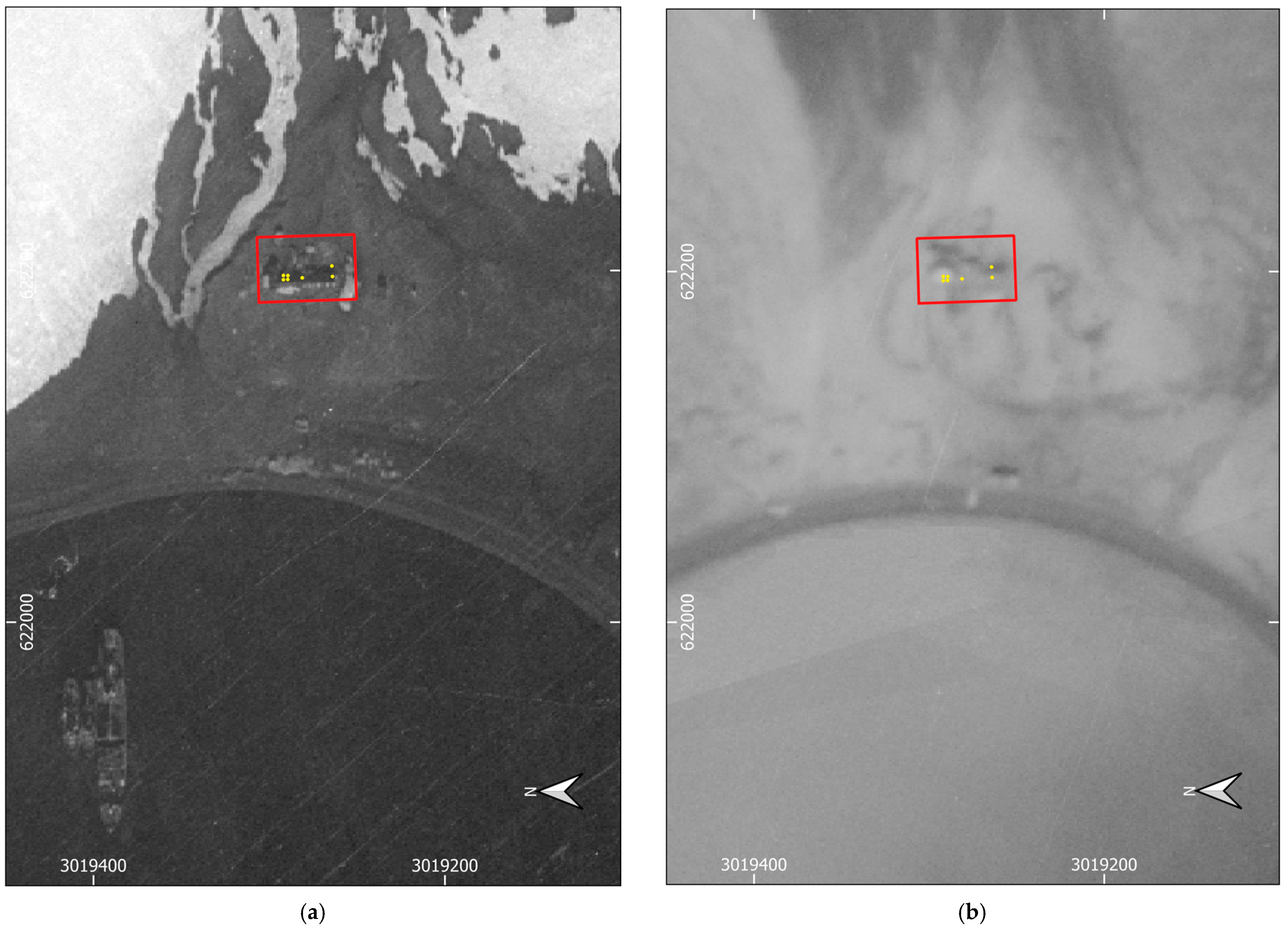

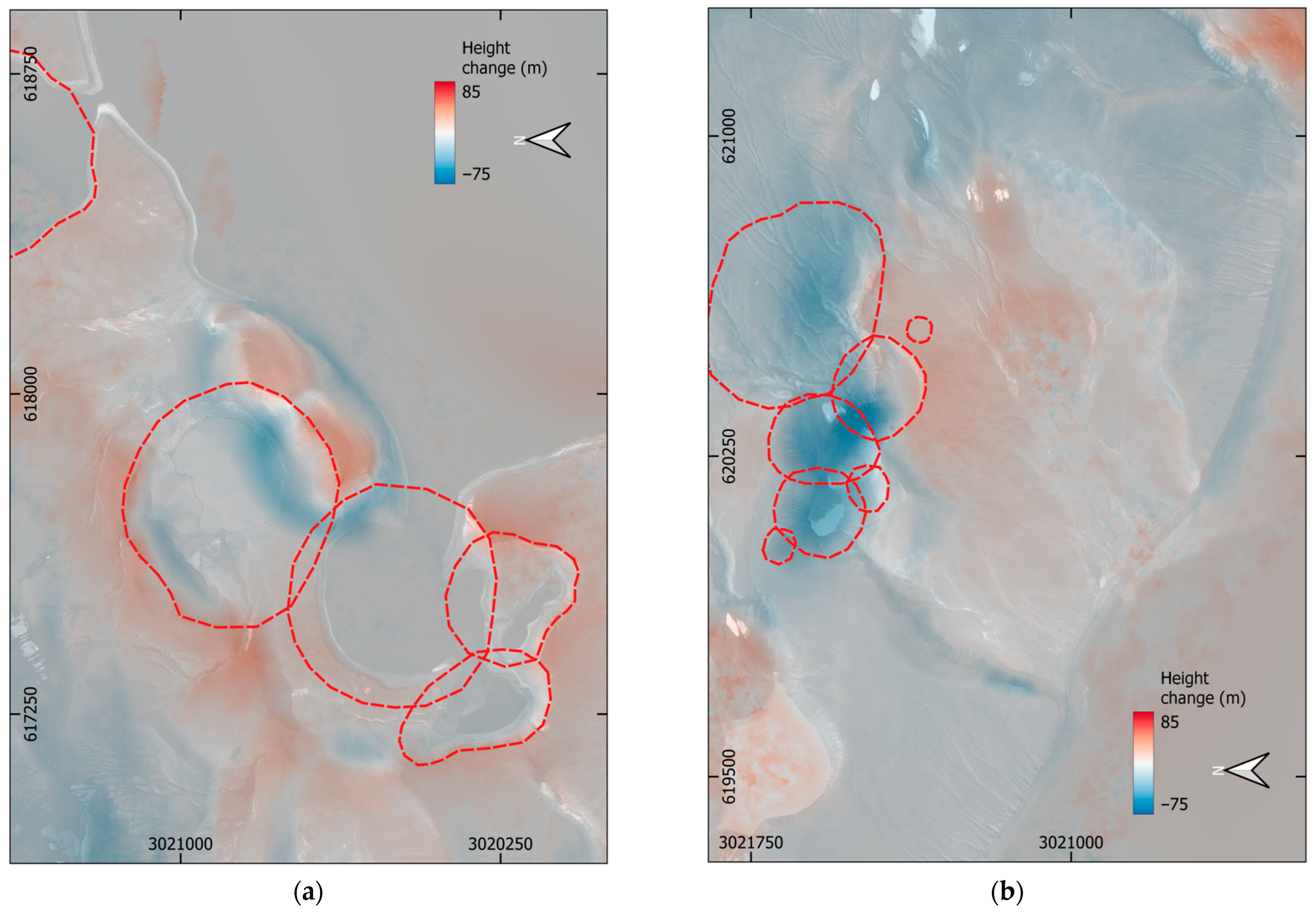
| Proprietary | Type and Details | Number of Frames/Images | Altitude and Scale | Date |
|---|---|---|---|---|
| The Falkland Islands and Dependencies Aerial Survey Expedition (FIDASE) | Fairchild metric camera f: 152.9 mm | 40 | 3960 m 1:26,000 | December 1956 |
| 22 | 4390 m 1:28,800 | December 1956 | ||
| Servicio de Hidrografía Naval Argentino (SHNA) | K-17 metric camera f: 152.4 mm | 30 | 4270 m 1:28,000 | January 1968 |
| Kompsat-3 | Panchromatic Four bands f: 8600.0 mm | 2 | 685,000 m | 19 February 2020 |
| Zone | Heights (m) | Partial Volume (km3) | Total Volume (km3) | Previous Volume (km3) |
|---|---|---|---|---|
| 1967 scoria cones (Telefon Bay) | - 53 | −0.002 +0.007 (+0.003) | 0.012 ± 0.003 | 0.05 [29] 0.057 [12] |
| 1967 crater (Land Craters) | - 151 | −0.017 +0.028 | 0.044 ± 0.007 | |
| 1967 ashfall (Deception Island) | 1 | +0.104 | 0.104 | |
| 1970 maar (Telefon Bay) | - | −0.003 +0.016 (+0.008) | 0.027 ± 0.005 | 0.04 [29] 0.053 [12] |
| 1970 craters (Land Craters) | 85 | −0.011 +0.011 | 0.022 ± 0.007 |
Disclaimer/Publisher’s Note: The statements, opinions and data contained in all publications are solely those of the individual author(s) and contributor(s) and not of MDPI and/or the editor(s). MDPI and/or the editor(s) disclaim responsibility for any injury to people or property resulting from any ideas, methods, instructions or products referred to in the content. |
© 2023 by the authors. Licensee MDPI, Basel, Switzerland. This article is an open access article distributed under the terms and conditions of the Creative Commons Attribution (CC BY) license (https://creativecommons.org/licenses/by/4.0/).
Share and Cite
Prates, G.; Torrecillas, C.; Berrocoso, M.; Goyanes, G.; Vieira, G. Deception Island 1967–1970 Volcano Eruptions from Historical Aerial Frames and Satellite Imagery (Antarctic Peninsula). Remote Sens. 2023, 15, 2052. https://doi.org/10.3390/rs15082052
Prates G, Torrecillas C, Berrocoso M, Goyanes G, Vieira G. Deception Island 1967–1970 Volcano Eruptions from Historical Aerial Frames and Satellite Imagery (Antarctic Peninsula). Remote Sensing. 2023; 15(8):2052. https://doi.org/10.3390/rs15082052
Chicago/Turabian StylePrates, Gonçalo, Cristina Torrecillas, Manuel Berrocoso, Gabriel Goyanes, and Gonçalo Vieira. 2023. "Deception Island 1967–1970 Volcano Eruptions from Historical Aerial Frames and Satellite Imagery (Antarctic Peninsula)" Remote Sensing 15, no. 8: 2052. https://doi.org/10.3390/rs15082052
APA StylePrates, G., Torrecillas, C., Berrocoso, M., Goyanes, G., & Vieira, G. (2023). Deception Island 1967–1970 Volcano Eruptions from Historical Aerial Frames and Satellite Imagery (Antarctic Peninsula). Remote Sensing, 15(8), 2052. https://doi.org/10.3390/rs15082052





